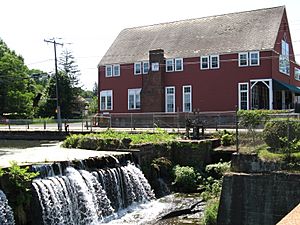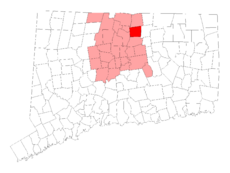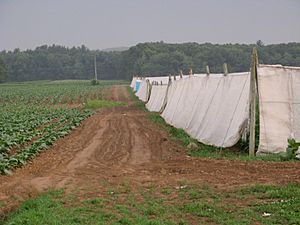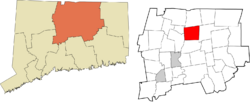East Windsor, Connecticut facts for kids
Quick facts for kids
East Windsor, Connecticut
|
|||
|---|---|---|---|
|
Town
|
|||
| Town of East Windsor | |||

The dam and Opera House in the Broad Brook section of town
|
|||
|
|||
| Nickname(s):
East Side/East Borough/E-Dubb
|
|||
| Motto(s):
Unity, Strength
|
|||
 Hartford County and Connecticut Hartford County and Connecticut |
|||
| Country | |||
| U.S. state | |||
| County | Hartford | ||
| Region | Capitol Region | ||
| Settled | 1680 | ||
| Incorporated | 1768 | ||
| Villages | Broad Brook Melrose Scantic Warehouse Point Windsorville |
||
| Government | |||
| • Type | Selectman-town meeting | ||
| Area | |||
| • Total | 26.8 sq mi (69.5 km2) | ||
| • Land | 26.3 sq mi (68.0 km2) | ||
| • Water | 0.6 sq mi (1.5 km2) | ||
| Elevation | 49 ft (15 m) | ||
| Population
(2020)
|
|||
| • Total | 11,190 | ||
| • Density | 417.0/sq mi (161.01/km2) | ||
| Time zone | UTC-5 (Eastern) | ||
| • Summer (DST) | UTC-4 (Eastern) | ||
| ZIP Codes |
06016, 06088
|
||
| Area code(s) | 860/959 | ||
| FIPS code | 09-24800 | ||
| GNIS feature ID | 0212329 | ||
| Major highways | |||
| U.S. Routes | |||
East Windsor is a town located in Hartford County, Connecticut, United States. It's part of the Capitol Planning Region. In 2020, about 11,190 people lived here. The town is made up of five smaller areas, often called villages: Broad Brook, Melrose, Scantic, Warehouse Point, and Windsorville.
Contents
- East Windsor's Story: A Look Back in Time
- Where is East Windsor? Understanding Its Geography
- Who Lives in East Windsor? A Look at the Population
- Learning in East Windsor: Schools and Education
- Getting Around: Transportation in East Windsor
- Fun Places to Visit in East Windsor
- Famous People from East Windsor
- See also
East Windsor's Story: A Look Back in Time
East Windsor has a long and interesting history. It started as part of a larger area claimed by settlers in 1633, which was then known as Windsor.
How Did East Windsor Begin?
The first English settler to use the land that is now East Windsor was William Pynchon. In 1636, he built a special storage building, called a warehouse, at a spot now known as "Warehouse Point." This warehouse was important for moving goods for his settlement in Springfield, Massachusetts.
Warehouse Point was a key location because it was near the Enfield Falls on the Connecticut River. This was the point where large ships had to stop. Goods then had to be moved to smaller boats. By building his warehouse there, Pynchon controlled much of the trade going up and down the northern Connecticut River.
For many years, until 1768, Warehouse Point was considered the southern border of Springfield, Massachusetts. Then, it became part of the Connecticut Colony.
Becoming Its Own Town
Most of what is now East Windsor was originally part of the larger Windsor settlement. Early settlers avoided the east side of the river because the Podunk tribe lived there. After a conflict called King Philip's War in 1675, people started to settle more on the east side. Simon Wolcott was one of the first settlers in this area.
East Windsor once included the areas that are now Ellington and South Windsor. On May 10, 1768, the East Windsor area officially separated from Windsor and became its own town. The original town center was in what is now East Windsor Hill, in South Windsor.
Dinosaur Discovery in East Windsor
In 1818, a resident named Solomon Ellsworth Jr. was digging a well near his house. He found some unusual bones! These bones were later sent to Yale University. Scientists there identified them as Dinosaur fossils, specifically from a dinosaur called an Anchisaurus.
This discovery was very important. While not the first fossils ever found, these were the first bones recognized as belonging to a dinosaur. This happened four years before another scientist, William Buckland, made a similar discovery. The bones are still at Yale, and Ellsworth's old house is still standing today.
Growth and Development of the Town
Over the years, East Windsor continued to grow.
- In 1832, the Broad Brook Mill was built near a waterfall.
- The town has five main sections: Warehouse Point, Broad Brook, Scantic, Melrose, and Windsorville. Warehouse Point is the oldest, used since the 1630s.
- Scantic used to be the main center of town before the mills were built.
- Windsorville was once its own small community with a church and post office.
- Mulnite Farms, a tobacco farm on Graham Road, started in 1905.
- The town's volunteer fire department was created in 1897.
- Broad Brook Elementary School opened in 1951.
- In 1961, the old town hall burned down. A new one was built on Rye Street.
- In 1986, the Broad Brook Mill caught fire during renovations. A new shopping area was later built on that site.
Where is East Windsor? Understanding Its Geography
East Windsor covers about 69.5 square kilometers (about 26.8 square miles). Most of this area is land, with about 1.5 square kilometers (0.6 square miles) being water.

Neighboring Towns and Rivers
East Windsor is surrounded by other towns:
- To the north: Enfield
- To the south: South Windsor
- To the east: Ellington
- To the west: Windsor Locks and Windsor, across the Connecticut River.
The Connecticut River was very important for trade in the past. Merchants used the river to ship goods like timber, bricks, and tobacco to places like the West Indies. They would then bring back sugar, salt, and manufactured goods. Small ships were even built along the river in areas like Warehouse Point.
Who Lives in East Windsor? A Look at the Population
| Historical population | |||
|---|---|---|---|
| Census | Pop. | %± | |
| 1820 | 3,400 | — | |
| 1840 | 3,600 | — | |
| 1850 | 2,633 | −26.9% | |
| 1860 | 2,580 | −2.0% | |
| 1870 | 2,882 | 11.7% | |
| 1880 | 3,019 | 4.8% | |
| 1890 | 2,890 | −4.3% | |
| 1900 | 3,158 | 9.3% | |
| 1910 | 3,362 | 6.5% | |
| 1920 | 3,741 | 11.3% | |
| 1930 | 3,815 | 2.0% | |
| 1940 | 3,967 | 4.0% | |
| 1950 | 4,859 | 22.5% | |
| 1960 | 7,500 | 54.4% | |
| 1970 | 8,513 | 13.5% | |
| 1980 | 8,925 | 4.8% | |
| 1990 | 10,081 | 13.0% | |
| 2000 | 9,818 | −2.6% | |
| 2010 | 11,162 | 13.7% | |
| 2020 | 11,190 | 0.3% | |
| U.S. Decennial Census | |||
According to the 2000 census, there were 9,818 people living in East Windsor. The population density was about 373.5 people per square mile.
Most of the people living in East Windsor were White (91.47%). Other groups included African American (4.09%), Asian (2.00%), and Hispanic or Latino (2.11%).
The average household had about 2.34 people, and the average family had about 2.94 people. About 27.5% of households had children under 18 living with them. The median age in the town was 39 years old.
The median income for a household was $51,092, and for a family it was $60,694. This means half the households earned more than this amount, and half earned less.
Learning in East Windsor: Schools and Education
East Windsor has schools for students of all ages.
Elementary Schools
The East Windsor Elementary School System serves students from pre-kindergarten up to fourth grade. The Connecticut Children's Place also offers schooling from fifth to twelfth grade. The principal of Broad Brook Elementary School is Laura Foxx.
Middle School
East Windsor Middle School is for students in grades five through eight. The principal is Timothy Field.
High School
East Windsor High School serves students from ninth to twelfth grade. The principal is Allison Anderson.
Getting Around: Transportation in East Windsor
East Windsor is easy to reach by road and is close to major cities.
Roads and Highways
U.S. Route 5 runs through the town. Interstate 91 also serves East Windsor with exits 44 and 45.
Travel Distances
East Windsor is located about 12 miles away from both Hartford and Springfield. The nearest passenger train station is Windsor Locks station.
Airports
Bradley International Airport is only about 5 miles away. There's also a smaller airstrip called Skylark Airport, which is used to help young pilots learn to fly.
Fun Places to Visit in East Windsor
East Windsor has several interesting places to explore!
- The Connecticut Trolley Museum and the Connecticut Fire Museum are both located in the Warehouse Point area. You can see old trolleys and fire trucks there.
- The East Windsor Academy Museum, run by the local historical society, is in the Scantic neighborhood. It's a great place to learn about the town's past.
- The Melrose School, now called the Melrose Library, is a historic one-room schoolhouse. It was used for teaching until the early 1900s and is now used for community events.
- St. John's Episcopal Church (Warehouse Point, Connecticut) in Warehouse Point is a historic building listed on the National Register of Historic Places.
Famous People from East Windsor
Many notable people have connections to East Windsor:
- Lorrin Andrews: A missionary to Hawaii and a judge.
- John Warner Barber: An engraver known for his detailed historical books.
- Israel Bissell: A post-rider who helped spread the news of the British attack in 1775.
- Daniel Bissell: A soldier and spy during the American Revolutionary War.
- Samuel Robbins Brown: A missionary to China and Japan.
- Eliphalet Chapin: A skilled cabinet and furniture maker.
- Aaron Civale: A pitcher for the Milwaukee Brewers baseball team.
- Jonathan Edwards: A famous theologian who grew up nearby.
- Frederick Holbrook: A former Governor of Vermont.
- Jerry Marquis: A former NASCAR race car driver.
- Walter Loomis Newberry: A businessman and philanthropist.
- Ryan Preece: A current NASCAR driver.
- Eli Terry: An inventor who received the first U.S. patent for a clock mechanism.
- Lizabeth A. Turner: A national president of the Woman's Relief Corps.
- Erastus Wolcott: An 18th-century member of the Connecticut General Assembly from East Windsor.
See also
 In Spanish: East Windsor (Connecticut) para niños
In Spanish: East Windsor (Connecticut) para niños




